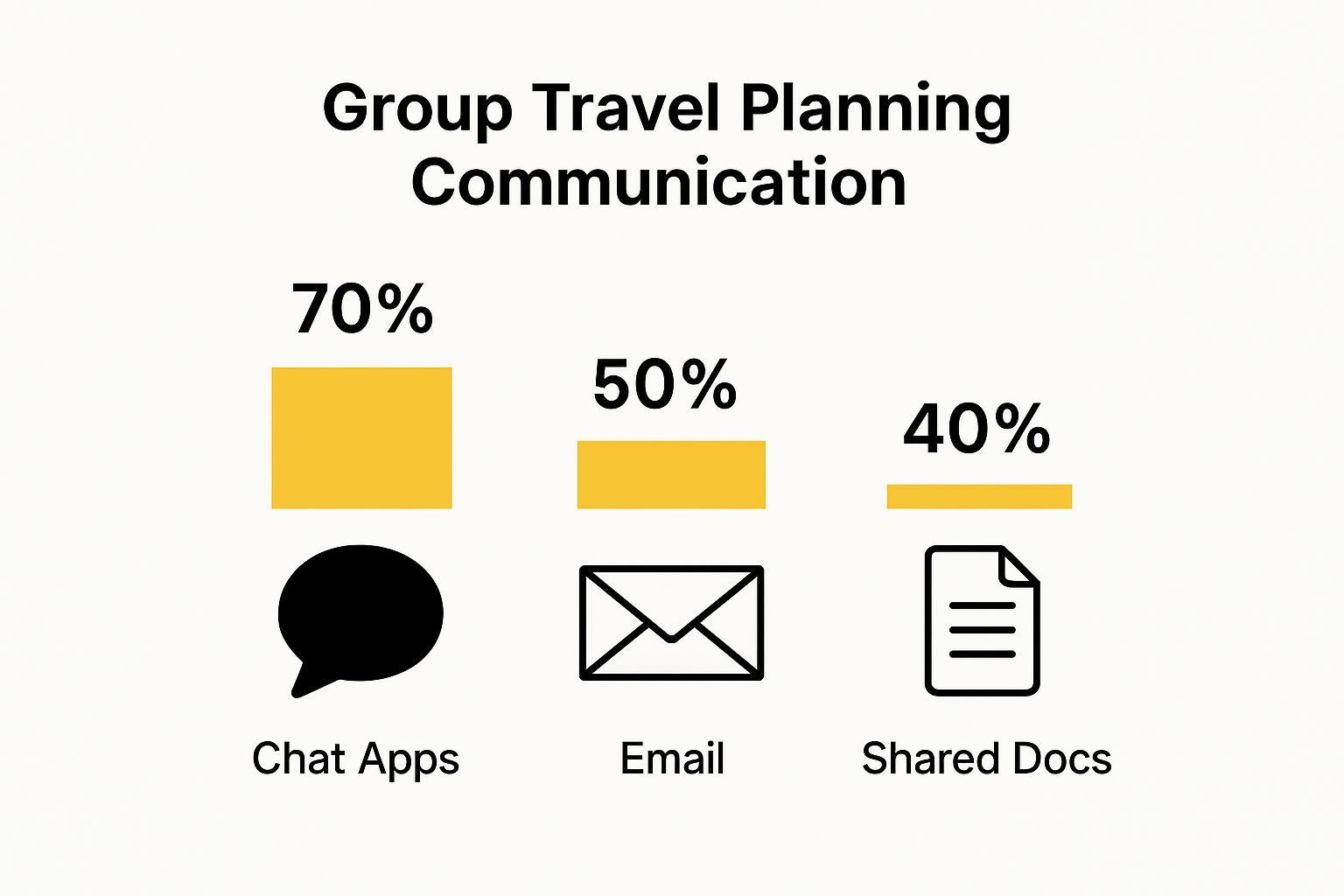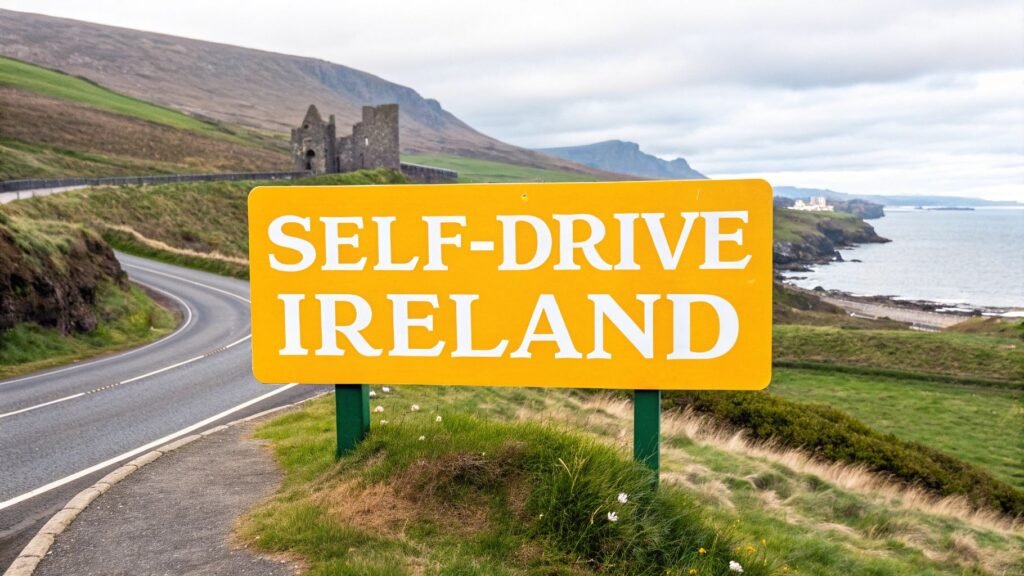Let’s be honest, planning group travel is the make-or-break moment for any group trip happens long before a single suitcase is packed. It’s all about laying the groundwork—getting everyone on the same page, figuring out what this trip is really about, and agreeing on the big stuff from the get-go. The secret to great group travel planning isn’t about picking the perfect destination first; it’s about starting with clear, open communication.
Building a Foundation for Your Group Trip

Before you even dream of browsing for flights or hotels, you need a solid foundation. I’ve seen countless brilliant trip ideas crumble simply because the core details weren’t nailed down early on. Getting this stage right saves a world of pain later and makes sure the trip is something everyone is genuinely excited about.
The first move is to gauge interest and get a read on the room. Don’t throw out a destination idea just yet. Instead, start a conversation. A simple poll using a tool like Doodle or even a quick survey in a dedicated WhatsApp group is perfect for this. This initial check-in just needs to cover the basics.
Pinpoint the Essentials Early
To avoid planning a trip that half the group can’t even join, you need to ask three non-negotiable questions right away:
- Potential Dates: When can everyone realistically go? Think in broad strokes for now, like “early summer” or “the October half-term.”
- Budget Comfort Level: What’s a rough budget range people are comfortable with for the main expenses like flights and accommodation? This is probably the most important filter you’ll have.
- General Vibe: What kind of trip are we talking about? A chill-by-the-pool holiday, a hectic city break packed with sightseeing, or an adventurous mountain trek? Nailing the travel style is key.
Remember, this isn’t about locking anything in. It’s about gathering the initial data that will shape all your future decisions. Having this information upfront helps you immediately discard unrealistic options and focus on what will actually work for everyone. This is especially true when you consider how often people in the UK travel. Recent research shows that 34% of people in the UK take 2-3 leisure trips annually, with another 13% taking four or more.
Expert Tip: From my experience, trying to get a full group consensus on every little thing leads to paralysis. It’s far more effective to nominate a trip leader or a small planning committee of two or three people. This keeps things moving, while major decisions can still be put to a group vote.
Define the Trip’s Purpose
With a clearer picture of budget and timing, it’s time to define the trip’s purpose together. Having a shared goal gives the trip a focus and makes every other decision that much simpler. Is the main event exploring historical ruins? Or is it all about tracking down the best food and nightlife? Maybe it’s just about getting away from it all and relaxing.
For groups who want the adventure without the planning headache, looking into professionally organised group tours can be a great source of inspiration and a way to bypass a lot of the logistical work.
This collaborative approach makes everyone feel heard right from the start, which sets a fantastic tone for the whole experience. It turns what could be a chore into an exciting, shared project.
Creating a Group Budget That Actually Works

Let’s be honest: talking about money can be the most awkward part of planning a group trip. But it really doesn’t have to be. Getting the budget right from the start, with everyone on board, is the secret to avoiding friction and making sure the trip is affordable for everyone involved. The aim isn’t to just land on a final number; it’s about creating a financial game plan that everyone understands and agrees to.
It all begins with breaking down the costs into simple, digestible pieces. A well-organised budget brings clarity and stops those surprise expenses from popping up and ruining the vibe.
Categorising Your Expenses
I’ve found the best way to think about a group budget is to split it into three distinct pots. This simple separation helps everyone see exactly where their money is going and gives them the flexibility to manage their own spending.
- Fixed Costs: These are the big, non-negotiable expenses that everyone shares equally. We’re talking about things like flights and the cost of your accommodation. Locking these in early gives you a solid financial foundation for the whole trip.
- Shared Variable Costs: This pot is for expenses the whole group enjoys together, but where the final bill can change. Think group dinners out, hiring a minibus for a day trip, shared taxis, or tickets for an attraction you’ve all agreed to visit.
- Personal Spending: This is crucial. It’s everyone’s individual money for anything not covered by the other two pots. This could be souvenirs, that morning coffee you grab on your own, optional tours, or an extra cocktail at the bar. Defining this clearly empowers people to spend within their own means without feeling any group pressure.
Approaching it this way makes the whole financial side of things feel much less intimidating. You’re no longer looking at one big, scary number, but a series of smaller, more manageable costs.
Tracking and Managing Payments
Once you’ve got your budget categories sorted, the next hurdle is actually handling the money. Chasing people for their share and dealing with a web of IOUs can quickly sour the mood. Thankfully, a few modern tools can make this process completely painless.
My number one piece of advice? Collect the money for all fixed costs upfront. This is non-negotiable. It means you can book flights and accommodation without the trip leader having to front a massive amount of cash. It also gets a firm commitment from everyone.
For all the little shared costs that come up during the trip itself, technology is your best friend.
- Splitwise: This app is an absolute lifesaver for group travel. Anyone in the group can add an expense they’ve paid for—like a round of drinks or a taxi fare—and the app cleverly calculates who owes what to whom. It keeps a running total that you can settle at the end, eliminating all the guesswork.
- Monzo: If your group is based in the UK, Monzo’s “Shared Tab” feature is brilliant. It works a lot like Splitwise, letting you track and split bills easily right within the banking app.
The Importance of a Contingency Fund
No matter how perfectly you plan, things can go wrong. A train might get cancelled, a fantastic last-minute tour opportunity might pop up, or a pesky booking fee appears out of nowhere. These things can throw a carefully planned budget completely off course. This is where a contingency fund saves the day.
I always recommend building a small buffer of 10-15% of the total fixed and shared costs into the budget. If you end up not needing it, great! Everyone gets a little refund at the end. That’s a much better conversation than having to ask for more money halfway through the holiday. It’s a simple step that provides massive peace of mind.
How to Craft an Itinerary Everyone Actually Loves

Right, now for the tricky part: building an itinerary that makes everyone happy. The secret to a successful group trip isn’t packing every single moment with activities. It’s about finding that sweet spot between planned fun and spontaneous discovery. This is where you turn all that talk about budgets and dates into a real, tangible plan.
The goal here is to create a shared adventure, not a military-style forced march. Nobody enjoys that.
Your initial research into what everyone can afford and what kind of trip they’re after is your foundation. Use it to narrow things down to two or three brilliant, well-thought-out destination ideas. Don’t just chuck a list of city names into the group chat; you need to sell the vision.
For each potential spot, I find it helps to put together a mini-pitch. Think of it like this:
- The Hook: A quick summary of what makes this place special for your group.
- The Reality Check: A simple list of pros and cons tailored to your crew. Is it a party spot or a chill-out zone? How’s the food?
- The Price Tag: A ballpark figure for flights and accommodation per person.
Doing this transforms what could be an endless, painful debate into a simple, collaborative choice. Everyone feels heard, and you guide the group towards a decision that’s both exciting and realistic.
Building Flexibility into Your Schedule
Once you’ve all agreed on a destination, the real art of planning group travel begins. The single biggest mistake I see people make? Over-scheduling. A jam-packed, minute-by-minute itinerary might look impressive on a spreadsheet, but in reality, it just leads to tired, grumpy travellers.
The real magic is in balancing structure with freedom. A great itinerary has a few “anchor” activities—the big, must-do things—but leaves plenty of gaps for people to do their own thing. Naps, wandering, finding a quirky café… that’s where the best memories often come from.
A good rule of thumb I’ve learned over the years is to plan just one major group activity per day. This might be a guided tour in the morning, a visit to a famous museum, or a booking at a fantastic restaurant for dinner. Then, leave the rest of the day, particularly the afternoon, pretty open. This gives everyone the breathing room to recharge or explore on their own.
This balanced approach is more important than ever. With international travel roaring back, popular places are getting crowded again. While the UK had only 245,000 visitors in the first quarter of 2021, forecasts for the third quarter of 2025 predict an incredible 12.5 million inbound visits. Having a flexible plan means you can dodge the worst of the crowds and adapt on the fly. You can read more about the UK’s rebounding tourism numbers and see why a rigid schedule might cause problems.
Making Room for Different Tastes
Let’s be honest: in any group, you’ll have a mix. You’ll have the early-riser who wants to go for a hike and the person who considers a slow morning with a coffee a sacred ritual. A great itinerary doesn’t just tolerate these differences; it embraces them.
Try building in optional activities. For example, maybe you book a city tour that everyone goes on in the morning. For the afternoon, you could suggest an optional wine tasting. Those who fancy it can go, while others are free to hit the shops or just relax by the pool.
This “choose your own adventure” style is a total game-changer for keeping the peace. It makes every single person feel like their holiday preferences matter, and that, right there, is the foundation of a truly memorable trip together.
Securing Your Group’s Flights and Stays
Once your group has locked in a destination and a budget, the trip starts to feel real. Now comes the nitty-gritty: booking the flights and a place to lay your heads. This is often where the real coordination challenges begin, but it’s also where you can find some fantastic deals if you know where to look.
Finding the Right Accommodation
Choosing where to stay is about so much more than just counting beds. The vibe of your trip can hinge on this decision. Do you go for a sprawling holiday home where everyone can hang out together, or book a block of hotel rooms for more privacy? It really comes down to your group’s personality.
I’ve found that for groups of 10 or more, it’s almost always worth picking up the phone and calling hotels directly. Forget the online booking sites for a moment. Most hotels have a group sales team that can access rates and perks you’ll never see online, like a block discount or even a free breakfast thrown in.
Insider Tip: When you call, don’t just ask for their “best price.” Frame it differently. Ask, “What can you do for a group of our size?” You’d be surprised what they might offer—maybe a complimentary meeting room for an evening get-together or a room upgrade for the person who did all the organising. It never hurts to ask!
If you’re looking to simplify things, exploring different group all-inclusive vacation options can be a brilliant move. These packages bundle accommodation, food, and often activities, which takes a huge load off your planning plate and makes budgeting a breeze.
Nailing Down Transport
When it comes to flights, I always start with an aggregator that has a flexible date search. This helps pinpoint the cheapest windows to travel. But be warned: booking for a large group directly on an airline’s website can sometimes trigger fraud alerts or just be plain clunky. If you’ve got more than eight people or a multi-stop journey, a travel agent specialising in group travel can be worth their weight in gold.
Don’t just think about flying, either. If you’re touring the UK or hopping between European cities, group rail passes are often far more cost-effective and scenic. For day trips and shorter journeys, hiring a minibus can work out cheaper and be a lot more fun than trying to coordinate a convoy of cars. If your group values its independence, you could even consider something like https://btours.com/self-drive-tours/ which gives you the structure of an itinerary but the freedom to explore at your own pace.
Keep Everything Organised
Right, once you’ve paid the deposits and the confirmations start rolling in, organisation becomes your best friend. My go-to method is to set up a shared folder on Google Drive that everyone can access. This becomes the single source of truth for the entire trip.
What goes in there? Everything.
- Flight confirmations and e-tickets
- Hotel or rental booking details, complete with addresses and check-in instructions
- Scans of passports and any required visas
- A master list of everyone’s emergency contact details

The image above shows a pretty common breakdown of how groups plan. WhatsApp is great for quick chats and “who wants pizza?” polls, but for the important stuff—the documents that can make or break a check-in—you need a central, reliable hub. This simple step prevents that last-minute panic when someone can’t find their booking reference at the airport desk.
Keeping Everyone in the Loop
Let’s be honest: great communication is the secret sauce to any successful group trip. When it works, the entire adventure feels effortless. But when it breaks down, even the tiniest hiccup can spiral into a major headache. The trick is to find that sweet spot—keeping everyone informed without drowning them in notifications.
I’ve learned that the best approach is to create two distinct channels for communication. You need one for fast-moving, real-time chatter and another as a permanent, reliable home for all the critical details. This simple separation keeps things organised and stops important info from getting buried under a mountain of travel selfies and dinner plans.
Set Up Your Communication Channels
First, you need a place for the day-to-day stuff. Think of it as your group’s digital nerve centre. A WhatsApp or Telegram group is brilliant for this. It’s where you’ll handle all the immediate, dynamic conversations: quick polls (“Lobby in 10, everyone?”), sharing a pin for that amazing coffee shop you just found, or just general trip banter.
But for the big, unchangeable details, you need a single source of truth. A shared Google Doc or even just a well-organised email thread can be a lifesaver. This is where you park the information people will need to look up again and again.
- The Master Itinerary: All the dates, times, addresses, and confirmation numbers in one place.
- Booking Details: Flight numbers, hotel confirmation codes, and tour reservation info.
- Emergency Info: A list of everyone’s emergency contacts. It’s one of those things you hope you never need, but you’ll be glad you have it if you do.
This system puts an end to the endless “what’s our flight number again?” questions that can clog up the chat. Before you all head off, I always recommend sending one final summary email with links to these documents, maybe adding a few packing tips to get everyone excited.
A well-crafted pre-trip email is more than just information; it’s a final checklist that builds excitement and makes sure everyone feels ready. A friendly reminder of the first meeting point, key timings, and a link to all the shared docs is the perfect send-off.
Staying Connected on the Road
Once you’re actually on the trip, the communication dynamic shifts. You need to stay connected, of course, but you also want to give people the freedom to do their own thing. Constant check-ins can feel a bit like a school trip, but too little communication can leave people feeling lost or disconnected.
A simple tactic that works wonders is to establish a loose daily check-in. This isn’t a formal roll call. It’s just a quick message in the group chat each morning to confirm the day’s main event or a default meeting spot for dinner. This gives everyone a framework for the day but leaves plenty of room for spontaneous exploration.
If people are looking for ideas for their free time, pointing them towards a resource with different travel destinations can spark some inspiration for individual adventures. It’s the perfect way to foster group togetherness while still respecting everyone’s desire for a bit of personal discovery.
Answering Your Burning Group Travel Questions
Let’s be honest, even the most meticulously planned group trip will hit a few bumps. Questions will come up, and unexpected situations will arise. The real secret to a successful trip isn’t about having a flawless plan from day one; it’s about anticipating the common sticking points so you can navigate them without breaking a sweat.
So, let’s dive into some of the most common challenges that pop up and how to handle them like a pro.
How Do We Make a Decision Without It Taking Forever?
Ah, decision paralysis. With a big group, it’s the number one killer of momentum. Trying to get ten people to agree on every little thing is a fast track to chaos.
A much smarter approach is to delegate. Nominate a small, trusted “planning committee” of two or three people, or even a single trip leader. Their job is to do the initial research and narrow down the big choices—like the destination or where you’ll stay—to just two or three fantastic options.
Once they present their findings, a quick poll in your group chat can seal the deal. This keeps everyone in the loop and gives them a say, but it cuts out the endless back-and-forth that can stall planning for weeks.
How Can We Split Costs Fairly When We All Have Different Budgets?
Talking about money can be awkward, but it’s a conversation you need to have upfront and with total transparency. The best way to tackle this is to agree on a “baseline” budget. This covers the non-negotiable shared expenses that everyone has to chip in for, like your accommodation and the main flights or train journeys.
Everything else? Make it optional.
That way, people on a tighter budget can gracefully skip the fancy tasting menu or the pricey zip-lining excursion without any pressure. Using an app like Splitwise throughout the trip is a lifesaver. It lets you easily track every shared coffee and taxi ride, so settling up at the end is fair, accurate, and completely drama-free.
My Two Cents: The aim is to create a trip where everyone feels included, regardless of their bank balance. Making pricier activities optional gives people control over their spending and is absolutely essential for keeping the group dynamic happy and healthy.
What Happens if Someone Drops Out at the Last Minute?
This is the big one, and it’s a scenario you need to plan for before a single pound has been spent. It’s crucial to establish a crystal-clear cancellation policy that everyone understands and agrees to from the get-go.
Your policy should spell out the firm deadlines for getting a full or partial refund. It also needs to be explicit about who is on the hook for any non-refundable deposits if someone has to pull out. Honestly, the best protection for everyone involved is to strongly recommend that each person gets their own travel insurance. It’s a safety net that protects against unexpected life events and gives the whole group peace of mind.
How Do We Build an Itinerary That Doesn’t Feel Like a School Trip?
The magic of a great group itinerary is all in the balance. You want structure, but you also need freedom. A brilliant rule of thumb is to plan just one main “anchor” activity for each day—maybe it’s a guided tour in the morning, a specific museum visit, or a reservation for a special dinner.
Then, leave the rest of the day—especially the afternoons—open for people to do their own thing. This built-in downtime allows smaller groups to form, individuals to wander off and explore their own interests, or for someone to simply head back for a nap. It stops the trip from feeling like a forced march and creates space for the spontaneous, memorable moments that make travelling so special. This is getting more important, too. With the UK expecting to welcome 43.4 million inbound visitors by 2025, a flexible plan is key to dodging the worst of the crowds. You can find more data on the UK’s growing tourism figures on VisitBritain.org.
At BTOURS, we specialise in taking the stress out of planning. Our self-drive tours through the UK, Ireland, and Greece offer the perfect blend of a curated itinerary and the freedom to explore at your own pace. Discover your next adventure at https://www.btours.com.



